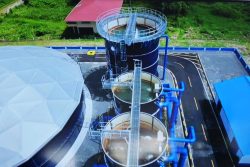The week before last the Ministry of Agriculture launched an action plan to eliminate illegal, unreported and unregulated (IUU) fishing. It was made possible, said the DPI, as a consequence of collaboration with various stakeholders, including government and international agencies. It seems to have been a response to a report undertaken for the government on illegal fishing, which said that in the year 2021 there were 19,000 vessel-days when foreign flagged fishing boats were recorded within Guyana’s EEZ. Over 2,600 of these, said the report, originated from Caricom member states.
According to the DPI, at the ceremony Minister of Agriculture Zulfikar Mustapha said the plan would ensure “there is a strategic framework involving government, industry, and international cooperation to combat IUU fishing and other forms of transnational organised crime linked to fisheries. It also includes measures to improve vessel monitoring, traceability, and stronger port controls.”
The report on the situation in 2021 stated that all vessels were required by law to carry a Vessel Monitoring System, however, the implementation of this was not universal. Industrial vessels, it said, were currently monitored by the Vessel Monitoring Centre, but the artisanal fishing industry is not, owing to the high cost involved for the fishers in acquiring monitoring equipment. It was reported that a consultation had been held under the action plan to promote the adoption of vessel monitoring by artisanal fishermen, so they would obtain transponders and service providers, although how this was to be paid for was not indicated. Small fishermen will lack the resources for that kind of capital investment.
Monitoring fishing in Guyana waters is a major challenge, because according to the 2021 report, the marine space to be covered is enormous in addition to which there are a large number of rivers as well as fishing vessels. Among other issues, mention was made of the fact there are no nationally designated landing sites for artisanal fishers, and the locations of several fishing communities as well as their mooring and landing sites afford only limited access. Added to all of this is the problem that the enforcement assets are insufficient to cover both the EEZ and internal waters, and there is a shortage of technical staff in the area of fisheries in general.
The Caricom figure for interlopers given in the 2021 report does not distinguish countries, although it is known that Suriname is a major offender. This it seems is being ignored in Paramaribo, when despite agreements with Guyana it has still not addressed the matter of exploitative licences for Guyanese fishermen operating in Suriname waters. It is perhaps worth noting that a representative of Suriname was present at the launch of the action plan.
In 2021 then Chief of Staff Godfrey Bess observed that the majority of vessels involved in illegal fishing came from Venezuela and Suriname. The Venezuelans particularly have been notorious in this regard over the decades, arrogantly regarding our marine space as theirs. They have too on occasion arrested our fishermen in our waters, as they did in 2021, claiming that two Guyanese vessels were “engaged in illegal fishing in flagrante delicto in waters of full sovereignty and jurisdiction of Venezuela, without also having any type of legal documentation.” Given the current crisis with Venezuela and the economic straits it is in, it is to be expected there will have been little diminution in the number of that country’s boats entering our maritime space for the purposes of illegal fishing.
This country has traditionally lacked the capacity to interdict the intruders, Brigadier Bess saying two years ago that the last time an illegal fishing vessel was brought inland here was some time in 2020. The government has in recent times been investing in the Coast Guard, however, something which may have played a role earlier this year when three Venezuelan pirates were arrested by the police and the Coast Guard in rough waters off the North West coast. Whether that upgrade has yet reached a level which would make for an effective force given the size of our EEZ is very doubtful.
While Minister Mustapha did refer in his presentation to international cooperation as being part of the strategic framework in the action plan, no details were given as to what this would entail. Certainly it is important as a starting point to be able to identify and monitor vessels, but eliminating illegal fishing would require adequate physical resources. Stronger port controls which the Minister alluded to, the government can surely institute, but arresting vessels is an entirely different matter, and for that international assistance would be required.
A defence partnership agreement was in fact signed between Guyana and the United States in January 2021 intended to secure increased safeguards against illegal fishing in this country’s waters, and it was followed by a joint exercise in relation to the problem. In July this year Southcom Commander Laura Richardson was reported as saying in an interview with Stabroek News there had been a significant success in combating illegal fishing in the region.
This was made possible through the multi-month deployment to the South Atlantic of the US Coast Guard vessel, the USCGC Stone which had countering illegal fishing as part of its mission. Following her description of a “huge success” General Richardson was quoted as going on to say, “A year to a year and a half ago we weren’t even talking about IUUF [Illegal, Unreported and Unregulated fishing].” It should be mentioned that Guyana is not the only South American country with which Southcom has agreements in relation to illegal fishing; others include Brazil, Argentina and Uruguay.
American concern about the matter has been largely stimulated by China’s industrial fishing practices, which are on an enormous scale. Not only is China the world’s largest seafood exporter, but its people consume one third of all fish worldwide. It has depleted its fish stocks in its own maritime waters, and is now hunting further and further afield to exploit fish resources in West Africa and Latin America, among other places. According to the Yale Environment 360 site “Most Chinese distant-water ships are so large that they scoop up as many fish in one week as local boats from Senegal or Mexico might catch in a year.”
Global Fishing Watch says that nearly half the world’s population relies on fish for 20 per cent of their animal protein, and illegal fishing removes access to this protein source. This results in lost revenue for legal fishers, and also places under threat the sustainable management of fish stocks. Fish form an important food source for Guyana’s population as well, and the industry provides work for a large segment of the coastal population.
If Chinese boats have not yet emerged along Guyana’s coast and in its EEZ, although they may have contracts with local fishers, there is, as indicated, still a problem with illegal fishing vessels. We will have to wait and see with what alacrity the new action plan is implemented, and how successful in addressing the problem it is.







